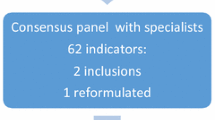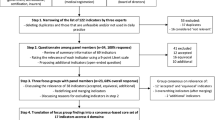Abstract
Objective
We present a score for assessing the quality of ICU care in terms of structure and process, based on bibliographic review, expert consultations, field test, analysis, and final consensus, and analyze its initial application in the field.
Design and setting
This feasibility and observational study was conducted within the framework of a French regional clinical research project (NosoQual); 40 ICUs were visited and assessed between November 2002 and March 2003 according to standardized procedures.
Measurements and results
The grid consisted of 95 variables. The overall score derived from seven independent quality dimensions: human resources, architecture, safety and environment, management of documentation, patient care management, risk management of infections and evaluation, and surveillance. The average level of achievement of the scores varied from 48% to 63% of theoretical maxima. Variability in the individual dimensional subscores was greater than that of the overall score (CV = 0.15).
Conclusions
Evaluation this scoring system encounters the limitation of the absence of a “gold standard.” However, this is counterbalanced by the rigorous design methodology, the characteristic strengths of the quality dimensions. The survey also highlights also feasibility and the potential interest for specific tools for the assessment of ICUs.



Similar content being viewed by others
References
Nora PF (2000) Improving safety for surgical patients: suggested strategies. Bull Am Coll Surg 85:11–14
Greengross P, Grant K, Collini E (1999) The history and development of the UK National Health Service 1948–1999. HSRC
Ministère de la Santé (1991) Loi n°91–748 du 31 juillet 1991 portant réforme hospitalière. J Officiel, Paris
Ministère de la Santé (1996) Ordonnance n°96–346 du 24 avril 1996 portant réforme de l'hospitalisation publique et privée. J Officiel, Paris
Donabedian A (1990) Contributions of epidemiology to quality assessment and monitoring. Infect Control Hosp Epidemiol 11:117–121
Donabedian A (1980) The Definition of quality and approaches to its assessment. Health Administration Press, Ann Arbor
Brun-Buisson C (1996) Practice guidelines for prevention of infection in European ICU's: a call for standards. Intensive Care Med 22:847–848
Wenzel RP (1992) Assessing quality health care: perspective for clinicians. Williams and Wilkins, pp 267–296
Thijs LG (1997) Continuous quality improvement in the ICU: general guidelines. Task Force European Society of Intensive Care Medicine. Intensive Care Med 23:125–127
Ferdinande P (1997) Recommendations on minimal requirements for intensive care departments. Members of the Task Force of the European Society of Intensive Care Medicine. Intensive Care Med 23:226–232
Piotrowski MM, Hinshaw DB (2002) The safety checklist program: creating a culture of safety in intensive care units. Jt Comm J Qual Improv 28:306–315
Joint Commission (2005) Specifications manual for national hospital quality measures-ICU. Joint Commission on Accreditation of Health Care Organizations, Oakbrook Terrace, Illinois
Miranda DR, Williams A Loirat P (1990) Management of intensive care: guidelines for the better use of resources. Kluwer
Depasse B, Pauwels D, Somers Y, Vincent JL (1998) A profile of European ICU nursing. Intensive Care Med 24:939–945
American College of Critical Care Medicine, Society of Critical Care Medicine (1999) Critical care services and personnel: recommendations based on a system of categorization into two levels of care. Crit Care Med 27:422–426
Norrenberg M, Vincent JL (2000) A profile of European intensive care unit physiotherapists. Intensive Care Med 26:988–994
Guidelines/Practice Parameters Committee of the American College of Critical Care Medicine, Society of Critical Care Medicine (1995) Guidelines for intensive care unit design. Crit Care Med 23:582–588
Ministère de la santé, de la famille et des personnes handicapées (2003) Circulaire DHOS/SDO/N° 2003/413 du 27 aot 2003 relative aux établissements de santé publics et privés pratiquant la réanimation, les soins intensifs et la surveillance continue. Bull Officiel, Paris
O'Connell NH, Humphreys H (2000) Intensive Care unit design and environmental factors in the acquisition of infection. J Hosp Infect 45:255–262
Francioli P, Muehlemann K (1999) Prévention des infections nosocomiales en réanimation. Swiss-Noso 6:13–15
Moro ML, Jepsen OB (1996) Infection control practices in intensive care units of 14 European countries. The EURO.NIS Study Group. Intensive Care Med 22:872–879
Harvey MA (1998) Critical-care-unit bedside design and furnishing: impact on nosocomial infections. Infect Control Hosp Epidemiol 19:597–601
Hoet T (1996) Conception des services de soins intensifs. Hygienes 12:50–54
O'Hara JF Jr, Higgins TL (1992) Total electrical power failure in a cardiothoracic intensive care unit. Crit Care Med 20:840–845
Agence nationale d'accréditation et d'évaluation en santé (2004) Manuel d'accréditation des établissements de santé. Ressources transversales—qualité et sécurité de l'environnement. ANAES, Paris, référence 16–20:37–382
Ministère de l'emploi et de la solidarité (1998) Élimination des déchets d'activités de soins à risques—guide technique. Ministère de l'emploi et de la solidarité, Paris
Agence nationale d'accréditation et d'évaluation en santé (2004) Manuel d'accréditation des établissements de santé. Ressources transversales—organisation de la qualité et de la gestion des risques. ANAES, Paris, référence 13–15:34–35
Comité Technique National des Infections Nosocomiales (2003) Désinfection des dispositifs médicaux en anesthésie et en réanimation. Ministère de la santé, de la famille et des personnes handicapées, Paris
Spaulding EH (1972) Chemical disinfection and antisepsis in the hospital. J Hosp Res 9:5–31
Centre de Coordination de la Lutte contre les Infections Nosocomiales du Sud-Ouest (2005) Entretien des locaux des établissements de soins. CCLIN Sud-Ouest, Bordeaux
Agence nationale d'accréditation et d'évaluation en santé (2004) Manuel d'accréditation des établissements de santé. Ressources transversales, Système d'information. ANAES, Paris, référence 21–24:41–42
Agence nationale d'accréditation et d'évaluation en santé (1994) Evaluation de la tenue du dossier du malade. ANAES, Paris
REANIS (n.d.) Guide de prévention des infections nosocomiales en réanimation, 2nd edn, EDK Glaxo Wellcome, Paris
Labadie JC, Kampf G, Lejeune B, Exner M, Cottron O, Girard R, Orlick M, Goetz ML, Darbord JC, Kramer A (2002) Recommendations for surgical hand disinfection—requirements, implementation and need for research. A proposal by representatives of the SFHH, DGHM and DGKH for a European discussion. J Hosp Infect 51:312–315
Hughes MG, Evans HL, Chong TW, Smith RL, Raymond DP, Pelletier SJ, Pruett TL, Sawyer RG (2004) Effect of an intensive care unit rotating empiric antibiotic schedule on the development of hospital-acquired infections on the non-intensive care unit ward. Crit Care Med 32:53–60
Timsit JF (2005) Updating of the 12th consensus conference of the Societé de Reanimation de langue française (SRLF): catheter related infections in the intensive care unit. Ann Fr Anesth Reanim 24:315–322
Long MN, Wickstrom G, Grimes A, Benton CF, Belcher B, Stamm AM (1996) Prospective, randomized study of ventilator-associated pneumonia in patients with one versus three ventilator circuit changes per week. Infect Control Hosp Epidemiol 17:14–19
Lepelletier D (2006) Meticillin-resistant Staphylococcus aureus: incidence, risk factors and interest of systematic screening for colonization in intensive-care unit. Ann Fr Anesth Reanim 25:626–632
Troche G, Joly LM, Guibert M, Zazzo JF (2005) Detection and treatment of antibiotic-resistant bacterial carriage in a surgical intensive care unit: a 6-year prospective survey. Infect Control Hosp Epidemiol 26:161–165
Acknowledgements
Participating ICUs from the REA Sud-Est network, L. Aysac and B. Tressières from the C.CLIN Sud-Est, the expert consultation group, investigation teams, Hospices Civiles de Lyon, CHRU de Montpellier, CHU de Nice and the French Ministry of Health. The ICUs participating in the survey were the following: Département Réanimation Urgences-SMUR, Centre Hospitalier, Ales; Réanimation polyvalente, Centre Hospitalier Juan-les-Pins, Antibes; Réanimation polyvalente, Centre Hospitalier, Arles; Réanimation, Centre Hospitalier Général, Aubagne; Réanimation, Centre Hospitalier, Aubenas; Réanimation médico-chirurgicale, Centre Hospitalier du Dr Récamier, Belley; Réanimation, Infirmerie Protestante, Caluire; Réanimation polyvalente, Centre Hospitalier, Cannes; Réanimation, Centre Hospitalier Antoine Gayraud, Carcassonne; Réanimation, Clinique du Parc, Castelnau-le-Lez; Réanimation polyvalente, Centre Hospitalier, Chambery; Réanimation polyvalente, Centre Hospitalier, Draguignan; Réanimation, Centre Hospitalier Fréjus–St. Raphaël, Fréjus; Réanimation polyvalente, Centre Hospitalier, Gap; Réanimation cardio-vasculaire et thoracique, Centre Hospitalier Universitaire, Grenoble; Réanimation chirurgicale 1 (URC), Centre Hospitalier Universitaire, Grenoble; Réanimation, Centre Hospitalier, La ciotat; Réanimation–Pavillon N, CHU Lyon–Hôpital Edouard Herriot, Lyon; Soins Intensifs Post-Opératoires–Unité 800, CHU Lyon–Hôpital Pierre Wertheimer, Lyon; Réanimation, Institut Paoli Calmette, Marseille; Réanimation, Clinique Vert Coteau, Marseille; Réanimation polyvalente, APHM–Hôpital Nord, Marseille; Réanimation, Centre Hospitalier, Martigues; Réanimation / USI, Polyclinique Saint Jean, Mimet; Réanimation polyvalente, Centre Hospitalier, Montelimar; Département d'Anesthésie Réanimation DAR-C, CHU Montpellier–Hôpital Gui de Chauliac, Montpellier; Département d'Anesthésie Réanimation DAR-B, CHU Montpellier–Hôpital Saint Eloi, Montpellier; Réanimation médicale et assistance respiratoire, CHU Montpellier–Hôpital Gui de Chauliac, Montpellier; Réanimation polyvalente, Centre Hospitalier, Narbonne; Réanimation polyvalente, CHU Nice–Hôpital Saint Roch, Nice; Réanimation, CHU Nice–Hôpital Archet 2, Nice; Réanimation, Centre Hospitalier, Privas; Réanimation polyvalente, Centre Hospitalier de Roanne, Roanne; Réanimation médicale, CHU Saint-Étienne–Hôpital Bellevue, Saint Etienne; Réanimation polyvalente, CHU Saint-Étienne–Hôpital Nord, Saint Etienne; Réanimation médico-chirurgicale, Hôpitaux du Pays de Mont-Blanc, Sallanches; Réanimation, Hôpitaux du Léman–Hôpital Georges Pianta, Thonon les Bains; Réanimation polyvalente, Hôpital Font-Pré, Toulon; Réanimation médico-chirurgicale, Centre Hospitalier Lucien Hussel, Vienne; Réanimation polyvalente, Centre Hospitalier, Villefranche sur Saone.; Réanimation, Centre Hospitalier Princesse Grace, Monaco; Réanimation chirurgicale–Réa Nord, CHU Lyon–Centre Hospitalier Lyon Sud, Lyon
Author information
Authors and Affiliations
Corresponding author
Electronic supplementary material
Rights and permissions
About this article
Cite this article
Najjar-Pellet, J., Jonquet, O., Jambou, P. et al. Quality assessment in intensive care units: proposal for a scoring system in terms of structure and process. Intensive Care Med 34, 278–285 (2008). https://doi.org/10.1007/s00134-007-0883-9
Received:
Accepted:
Published:
Issue Date:
DOI: https://doi.org/10.1007/s00134-007-0883-9




